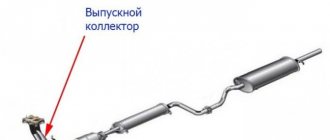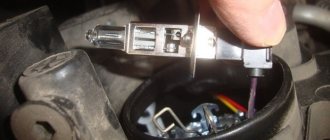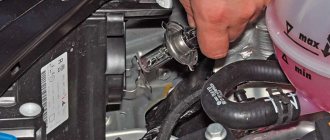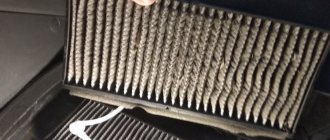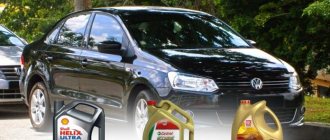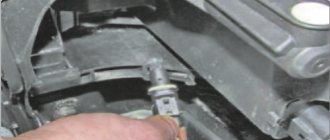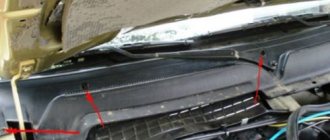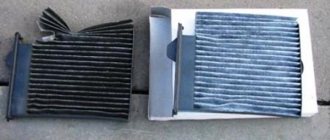It is recommended to change the Volkswagen Polo cabin filter every 30 thousand kilometers or once every twenty-four months. This is what the instructions of the European automaker dictate. However, Russian reality makes its own adjustments. Selecting a new cabin filter and the frequency of its replacement is not a small thing.
According to reviews from car owners, the question of changing the filter will arise in about three months.
And this is when driving on ordinary asphalt city roads.
Replacing the cabin filter on Polo
A number of signs indicate that it’s time to change the cabin filter on a VW Polo:
- the suffocating stench from trucks and buses, especially diesel engines;
- dusty doors and dashboard;
- weakening of air recirculation;
- constant fogging of windows.
These are obvious reasons. But even if they are not so pronounced, you should not endure and delay the replacement process. Indeed, in addition to unpleasant odors and dust, there are also harmful microorganisms that affect the lungs and bronchi, making breathing difficult.
Where is the cabin filter located?
In all Volkswagen Polo trim levels, the cabin filter (carbon, dust or combined type) is located at the foot of the front passenger, under the cover, which protrudes the most. When dismantling, it is removed, and the filter itself is pulled down.
How to replace
Replacing the Volkswagen Polo cabin filter occurs according to the following principle:
- First, take out the old filter. It's quite simple, but inconvenient: you have to kneel down and look down to see the holder cover.
- Two movable holders move. The cover can now be removed.
- The filter is carefully pulled down to remove.
All that remains is to replace it with a new one, cleaning the cartridge from the inside.
Selecting a cabin filter for VW Polo Sedan
If you are sure that the time has come to replace the filter, your first task is to choose a suitable filter. Its solution will be much simpler if you know what kind of cabin filters there are, what their structure is and how they work. Currently, the most common types of filter elements are:
- single-layer, providing protection from large pollutants visible to the naked eye (poplar fluff, insects, pollen, leaves);
- two-layer, containing an additional layer for fine air purification from invisible microparticles (dust, exhaust gases, microscopic pieces of rubber from protectors, soot);
- three-layer, in which an additional layer of activated carbon provides protection against the penetration of volatile substances (sources of unpleasant odors) and pathogenic microflora (bacteria, microbes, fungus) into the cabin.
Original products (catalog number VAG 6R0820367) do their job quite well, but they are quite expensive, about 700 rubles, which, if replaced frequently, can significantly affect the car owner’s budget. In addition, these are ordinary anti-dust products without a carbon layer. Coal analogues are also available for sale (No. VAG 6R0820367), but they are not standardly installed and are even more expensive.
In fact, German designers tried to significantly facilitate car maintenance for its owners, so the Polo Sedan cabin filter (both carbon and regular) has standardized dimensions and design, which allows the use of products from many independent manufacturers. Here is a short list of the most famous size-compatible filters:
- VAG (catalog no. 6R0820367/6R0819653);
- Filtron (cat. no. K1079/K1313);
- Mann (cat. no. CU26010/CUK26010);
- Valeo (catalog no. 715737/708685).
Here, the code of the regular product is indicated first, followed by a slash for the coal version.
There are also good reviews about filters from Bosch (catalog no. 1987432057), Corteco (catalog no. 80001783), Delphi (catalog no. TSP0325339), Lynx (catalog no. LAC1006), Patron (catalog no. PF2041), TSN (catalog no. 9784).
Original or analogue
So, it is already clear that replacing the filter on the Polo sedan will cost a pretty penny, because it will have to be changed often. The original filter for the Volkswagen Polo - VAG 6R0820367 - costs more than a thousand rubles. But there are many more budget analogues that are not inferior in quality to the original:
Read also Steering rack Volkswagen Passat B3: repair or replacement
| Firm | vendor code | Estimated cost, rub. |
| BOSCH | 1987432357 | 600 |
| Knecht | LA120 | 600 |
| Mann | CUK2545 | 750 |
| HENGST FILTER | E961LC | 450 |
| FILTRON | K1079A, | 200 |
| Sat | ST-6R0820367 | 200 |
| Amiwa | 20-01-049 | 250 |
| FILTRON (dust) | K1313 | 150 |
| Miles, | AFW1294 | 200 |
When choosing an analogue, you should focus on the dimensions of the original - which is 255 x 224 x 35 mm. Many analogues differ; it is important that the discrepancy is not critical - does not exceed half a centimeter.
Otherwise, dust will settle on the heating radiator and further on the lungs of those in the cabin.
Catalog numbers (articles)
The VAG concern produces 2 types of filter elements: conventional (paper) and carbon. The former are preferable to use in small cities, since they purify the air only from dust and do not absorb fuel combustion products.
Carbon elements absorb fuel combustion products and other odors entering the cabin through the air intake. In a big city, it is better to use carbon purifiers for the air entering the cabin.
Original
Article TypeAverage price, rub.
| 6R0820367 | paper | 918 |
| 6R0 819 653 | carbonic | 1172 |
Analogs 6R0 820 367
ManufacturerArticle Average price, rub.
| A GRESSOR | 3AC0123 | 503 |
| ACDELCO | 19372706 | 407 |
| ALCO FILTER | MS6438 | 412 |
| AM ENG | 4638 | 204 |
| AMD | AMDFC741 | 256 |
| AMIWA | 2001049 | 241 |
| CORTECO | 80001783 | 659 |
| DELPHI | TSP0325339 | 560 |
| DEXTRIM | DX40084 | 230 |
| DODA | 1110050071 | 207 |
| FEBI | 37314 | 676 |
| FILTRON | K1313 | 251 |
| FRAM | CF9323 | 510 |
| GUD | GCF26010 | 213 |
| GANZ | GIR03004 | 289 |
| HENGST FILTER | E3919LI | 375 |
| IBERIS | IB772053 | 241 |
| JC PREMIUM | B4W021PR | 402 |
| KAMOKA | F416001 | 547 |
| KITTO | AC0198 | 360 |
| LYNX | LAC1917 | 268 |
| MANN FILTER | CU26010 | 478 |
| MASTER SPORT | 2545IFPCSMS | 338 |
| MEAT DORIA | 17542 | 539 |
| METACO | 1010007C | 318 |
| MFILTER | K9069C | 499 |
| MFILTER | K9069 | 278 |
| MILES | AFW1294 | 200 |
| MISFAT | HB151 | 402 |
| NORDFIL | CN1035 | 136 |
| PATRON | PF2260 | 272 |
| PROFIT | 15212339 | 260 |
| PURFLUX | AH191 | 432 |
| QUATTRO FRENI | QF20Q00107 | 300 |
| REDSKIN | AC0198 | 332 |
| RU54 | CF1313 | 382 |
| SAKURA | CA49010 | 408 |
| SAT | ST6R0820367 | 166 |
| SCT | SA1291 | 230 |
| SOFIMA | S3190C | 706 |
| TOPRAN | 113491055 | 387 |
| TORQUE | RSD111 | 141 |
| VEMO VAICO | V10302529 | 457 |
| VIKA | 19118 | 294 |
| WIX FILTERS | WP2086 | 472 |
| ZEKKERT | IF3020 | 308 |
| NEVSKY FILTER | NF6429 | 161 |
Analogs 6R0 819 653
ManufacturerArticle Average price, rub.
| 3F QUALITY | 714 | 452 |
| AMD | AMDFC741C | 409 |
| BLUE PRINT | ADV182511 | 569 |
| BOSCH | 1987435502 | 780 |
| DELPHI | TSP0325339C | 688 |
| DEXTRIM | DX40084C | 332 |
| FEBI | 37316 | 1041 |
| GUD | GCF26010C | 367 |
| GUD | GCF2545C | 347 |
| KAMOKA | F503301 | 585 |
| KAMOKA | F509701 | 600 |
| KUJIWA | KUK0198 | 259 |
| LYNX | LAC1917C | 488 |
| MAHLE KNECHT | LAK809 | 854 |
| MANN FILTER | CUK26010 | 718 |
| MILES | AFC1294 | 370 |
| PATRON | PF2419 | 350 |
| SWAG | 30937316 | 687 |
| VALEO | 715727 | 998 |
| VEMO VAICO | V10312529 | 1224 |
| VIKA | 88190938301 | 300 |
| ZEKKERT | IF3020K | 405 |
| NEVSKY FILTER | NF6123C | 307 |
Possible difficulties
The difficulty in selecting any spare parts comes from pirates and their products. However, if you look closely, it is easy to distinguish the original. Please pay attention to:
- Label print quality. You should especially be wary of blurry letters and also mistakes in words.
- Differences in the quality of printing on the product and packaging.
- Articles. The carbon filter cannot have the dust number on it and vice versa.
- Build quality. Sloppy assembly with glue drips indicates a fake.
You also need to look at discounts - if the seller names a very low price, this should alert you.
Where is SF located?
How many cars, so many places. This, of course, is all a joke. There are three possible locations for the cabin filter. This is the engine compartment, the place under the control pedals and the glove box (immediately behind it). In the Polo Sedan car there is a cabin filter under the control pedals. It is located specifically to the right of the floor tunnel (cladding side).
If this is your first time replacing the cabin air filter, then our article will be very useful to you. So what do we need?
Answers on questions
The question most often asked about the cabin filter is: does it make sense to replace it with a carbon one?
Answer : coal does make the air inside the cabin cleaner - there is no burning smell from diesel engines at all - but it will have to be changed more often. In any case, you won’t be able to save much here.
So, replacing the filter on a Volkswagen Polo is not a difficult task, even a beginner can do it. When choosing a new filter, you should be careful and monitor price and quality. There is a high risk of acquiring ersatz.
Regulations
According to the regulations, a scheduled replacement of the cabin filter is carried out every 30 thousand km of the vehicle or once every two years.
The time frame may be significantly reduced. The reason for this:
- Aggressive driving style.
- Regular travel along dusty country roads.
- Issues related to ecology.
The work can be considered the most common procedure during routine car maintenance. For removal and installation you will need:
- New filter.
- Flashlight.
- Rags.
- Car vacuum cleaner for cleaning the interior.
When to change, what interior to install
To perform scheduled maintenance operations, there are regulations, as well as manufacturer recommendations. According to them, replacing the cabin filter of the heating and air conditioning system of the Volkswagen Polo Sedan V Mk5 should be done every 15,000 kilometers or once a year.
Considering that the operating conditions of the car in most cases will be far from ideal, experts advise performing this operation approximately twice as often, in spring and autumn.
Characteristic symptoms:
- Windows often fog up;
- the appearance of unpleasant odors in the cabin when the airflow is turned on;
- deterioration of the stove and air conditioner;
They may make you doubt that the filter element is coping with its tasks and an unscheduled replacement will be required. In principle, these symptoms should be relied upon when choosing the correct replacement interval.
Suitable sizes
When choosing a filter element, owners do not always use products recommended by the car manufacturer. Everyone has their own reasons for this, some say that the original is unreasonably expensive. Some people in the region sell only analogues, so there is a need to know the sizes by which you can subsequently make a selection:
- Height: 36 mm
- Width: 254 mm
- Length: 224 mm
As a rule, sometimes analogues for the Volkswagen Polo Sedan V Mk5 may be a few millimeters larger or smaller than the original, there is nothing wrong with that. And if the difference is measured in centimeters, then of course it’s worth looking for another option.
Selecting an original cabin filter
The manufacturer recommends using exclusively original consumables, which, in general, is not surprising. They themselves are of good quality and are widely available in car dealerships, but their price may seem overpriced to many car owners.
Regardless of the configuration, on all fifth-generation Volkswagen Polo Sedan (including the restyled version), the manufacturer recommends installing a cabin air filter, a dust filter with item number 6R0820367 (VAG 6R0 820 367) or a carbon filter with number 6R0819653 (VAG 6R0 819 653).
It is worth noting that sometimes consumables and other spare parts may be supplied to dealerships under different part numbers. Which can sometimes confuse those who want to purchase an original product.
When choosing between a dust and carbon product, car owners are advised to use a carbon filter element. This filter is more expensive, but it cleans the air much better.
It is easy to distinguish - the paper filter accordion is impregnated with a carbon composition, and therefore has a dark gray color. The filter cleans the air flow from dust, fine dirt, germs, bacteria and enhances the protection of your lungs.
Which analogues to choose
In addition to simple cabin filters, there are also carbon filters that filter the air more effectively, but they are more expensive. The advantage of coal SF is that it does not allow foreign odors coming from the road (street) to penetrate into the car interior.
But this filter element also has a drawback - air does not pass through it well. GodWill and Corteco carbon filters are of fairly high quality and are a good replacement for the original.
However, in some retail outlets the price of the original fifth-generation Volkswagen Polo Sedan cabin filter may be greatly overpriced. In this case, it makes sense to purchase a non-original consumable item. In particular, cabin filters are considered quite popular:
Conventional dust cabin filters
- MANN-FILTER CU26010 – high-tech consumables from a well-known manufacturer
- BIG Filter GB-9973 – popular brand, good fine cleaning
- Filtron K1313 is a good manufacturer with an affordable price
Carbon cabin filters
- MANN-FILTER CUK26010 – high-quality and thick carbon coating
- BIG Filter GB-9973/C – activated carbon
- TSN 9.7.885 – normal quality, affordable price
It makes sense to take a closer look at the products of other companies - they also specialize in the production of high-quality consumables for passenger cars:
- Corteco
- Filtron
- SCT
- Sakura
- GoodWill
- Fram
- JS Asakashi
- Champion
- Zekkert
- Masuma
- Nipparts
- Purflux
- Knecht Mahle
It is quite possible that sellers may recommend replacing the Polo Sedan V Mk5 cabin filter with non-original cheap substitutes with a much smaller thickness. They are not worth buying, since their filtering characteristics are unlikely to be at the proper level.
Signs of contamination
If problems arise at work, this may be expressed by the following symptoms:
- You can often see windows sweating.
- The dashboard remains dirty even when the driver drives with the windows closed.
- There is always dirt on the inside of the windshield.
- The microclimate gradually became less comfortable: sometimes it was too hot, sometimes too cool.
- There are clearly unpleasant odors in the cabin. The source of which cannot be identified.
If one or more of the symptoms mentioned in the list occur, you can be sure that the cabin filter is not working well and needs to be replaced.
